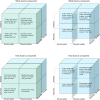Perspective: A Framework for Addressing Dynamic Food Consumption Processes
- PMID: 34999744
- PMCID: PMC9340970
- DOI: 10.1093/advances/nmab156
Perspective: A Framework for Addressing Dynamic Food Consumption Processes
Abstract
The study of food consumption, diet, and related concepts is motivated by diverse goals, including understanding why food consumption impacts our health, and why we eat the foods we do. These varied motivations can make it challenging to define and measure consumption, as it can be specified across nearly infinite dimensions-from micronutrients to carbon footprint to food preparation. This challenge is amplified by the dynamic nature of food consumption processes, with the underlying phenomena of interest often based on the nature of repeated interactions with food occurring over time. This complexity underscores a need to not only improve how we measure food consumption but is also a call to support theoreticians in better specifying what, how, and why food consumption occurs as part of processes, as a prerequisite step to rigorous measurement. The purpose of this Perspective article is to offer a framework, the consumption process framework, as a tool that researchers in a theoretician role can use to support these more robust definitions of consumption processes. In doing so, the framework invites theoreticians to be a bridge between practitioners who wish to measure various aspects of food consumption and methodologists who can develop measurement protocols and technologies that can support measurement when consumption processes are clearly defined. In the paper we justify the need for such a framework, introduce the consumption process framework, illustrate the framework via a use case, and discuss existing technologies that enable the use of this framework and, by extension, more rigorous study of consumption. This consumption process framework demonstrates how theoreticians could fundamentally shift how food consumption is defined and measured towards more rigorous study of what, how, and why food is eaten as part of dynamic processes and a deeper understanding of linkages between behavior, food, and health.
Keywords: diet; dietary assessment; dynamics; eating behavior; food consumption; food logging; food systems; precision health; precision nutrition; systems science.
© The Author(s) 2022. Published by Oxford University Press on behalf of the American Society for Nutrition.
Figures




References
-
- Steck SE, Murphy EA. Dietary patterns and cancer risk. Nat Rev Cancer. 2020;20(2):125–38. - PubMed
-
- Ubago-Guisado E, Rodríguez-Barranco M, Ching-López A, Petrova D, Molina-Montes E, Amiano P, Barricarte-Gurrea A, Chirlaque MD, Agudo A, Sánchez MJ. Evidence update on the relationship between diet and the most common cancers from the European Prospective Investigation into Cancer and Nutrition (EPIC) study: a systematic review. Nutrients. 2021;13(10):3582. - PMC - PubMed
-
- Herman CP. The social facilitation of eating: a review. Appetite. 2015;86:61–73. - PubMed
Publication types
MeSH terms
LinkOut - more resources
Full Text Sources
Miscellaneous

